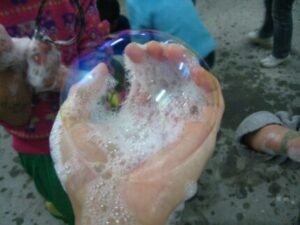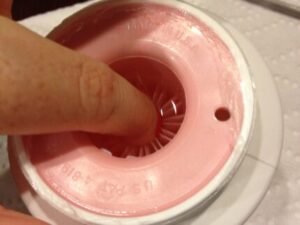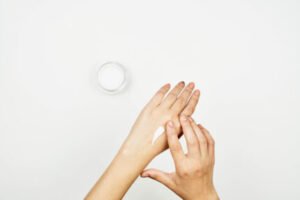Medically reviewed by Dr. Ramesh Gaddam, M.D. — Written by Sumalatha, D.N.H.E
Wait for it to dry
Waiting for wet nail glue to dry is crucial in preventing further spread and making the removal process easier and more effective.

Here’s a detailed explanation of why waiting is important and what can happen if you try to remove wet nail glue:
Prevents Spreading:
Wet nail glue is highly adhesive and can easily spread to surrounding areas if touched or manipulated.
Attempting to wipe or remove wet glue can cause it to smear across your skin, making the situation messier and more challenging to clean up.
Avoids Smudging:
Wet nail glue tends to be sticky and can adhere to surfaces it comes into contact with, including your fingers and nearby skin.
Touching wet glue can lead to smudging and smearing, making it more difficult to distinguish between the glue and your skin.
Minimizes Skin Contact:
Wet nail glue can be irritating to the skin, especially if it contains harsh chemicals.
Allowing it to dry reduces the likelihood of prolonged contact with your skin, minimizing the risk of irritation or adverse reactions.
Facilitates Removal:
Once the nail glue has dried, it forms a solid bond that is easier to manipulate and remove from the skin.
Dry glue tends to become brittle, allowing you to gently peel or roll it off without causing damage to your skin.
In summary, waiting for nail glue to dry completely is essential to prevent spreading, smudging, minimize skin contact, and facilitate easier removal.
Patience during this waiting period will ultimately lead to a more successful and hassle-free removal process.
Soak in warm, soapy water
Soaking the affected area in warm, soapy water is an effective method for loosening nail glue from your skin.

Here’s a detailed explanation of how this process works and why it’s beneficial:
Warm Water:
Warm water helps to soften the nail glue, making it more pliable and easier to remove from the skin.
The warmth also helps to relax the skin, which can aid in the removal process without causing discomfort or irritation.
Mild Soap:
Adding a few drops of mild soap to the warm water helps to create a gentle solution that can break down oils and debris on the skin, including any residue from the nail glue.
The soap also helps to create a slippery surface, making it easier to manipulate and remove the glue.
Loosening Effect:
As you soak the affected area in warm, soapy water, the combination of heat and moisture works to loosen the bond between the nail glue and your skin.
This allows the glue to become more pliable and easier to manipulate, making it simpler to remove without causing damage to your skin.
Gentle Method:
Soaking in warm, soapy water is a gentle and non-invasive method for removing nail glue from the skin.
It is suitable for most skin types and is less likely to cause irritation or discomfort compared to more aggressive removal methods.
Overall, soaking the affected area in warm, soapy water is an effective and gentle way to loosen nail glue from your skin, making it easier to remove without causing damage or irritation.
Gently peel or roll off
After soaking your skin in warm, soapy water to loosen the nail glue, the next step is to gently peel or roll off the glue using your fingertips or a soft cloth.

Here’s a detailed explanation of how to proceed with this step and why it’s important to be gentle:
Soaking Preparation:
Before attempting to peel off the nail glue, ensure that you have soaked the affected area in warm, soapy water for several minutes.
This process softens the glue, making it easier to manipulate and remove without causing damage to your skin.
Gentle Peeling:
Using your fingertips or a soft cloth, gently attempt to peel off the softened nail glue from your skin.
Start at the edges of the glued area and work your way towards the center, using slow and careful motions.
Avoid Tugging:
It’s essential to avoid tugging too hard when peeling off the nail glue, as this can irritate or damage the skin.
Instead, apply gentle pressure and take your time to ensure that you’re removing the glue without causing any discomfort.
Rolling Technique:
If peeling off the glue proves to be challenging, you can try using a rolling motion with your fingertips or a soft cloth.
This technique involves gently rolling the softened glue away from the skin, gradually loosening its grip without pulling or tugging.
Patience and Persistence:
Depending on the amount of nail glue and how long it has been on your skin, removing it may require patience and persistence.
Take breaks if needed and continue the gentle peeling or rolling process until all the glue has been successfully removed.
By gently peeling or rolling off the nail glue after soaking, you can effectively remove it from your skin without causing irritation or damage. Remember to proceed with care and patience to achieve the best results.
Use an acetone-based nail polish remover
If the nail glue proves to be stubborn and doesn’t come off with warm, soapy water or gentle peeling, you can try using an acetone-based nail polish remover.

Here’s how to safely use nail polish remover to remove stubborn nail glue from your skin:
Prepare the Nail Polish Remover:
Ensure you have an acetone-based nail polish remover on hand.
Acetone is a powerful solvent that can effectively dissolve nail glue.
Soak a cotton ball or pad with the remover, ensuring it’s saturated but not dripping.
Apply to the Affected Area:
Gently dab the soaked cotton ball or pad onto the glued area of your skin.
Be careful not to rub too vigorously, as this can irritate the skin.
Allow the nail polish remover to sit on the glue for a few minutes to soften and dissolve it.
Gently Wipe or Peel Away:
After letting the nail polish remover sit for a few minutes, gently wipe or peel away the softened nail glue using a soft cloth or your fingertips.
Start at the edges and work your way towards the center, using gentle motions to avoid irritating the skin.
Repeat if Necessary:
Depending on the stubbornness of the nail glue, you may need to repeat the process multiple times to completely remove it from your skin.
Take breaks between applications to avoid excessive exposure to acetone, which can be drying to the skin.
Rinse and Moisturize:
Once you’ve successfully removed the nail glue, rinse the affected area with lukewarm water to remove any remaining residue.
Pat the skin dry with a clean towel and apply a moisturizer to soothe and hydrate the skin, as acetone can be drying.
Be Cautious with Acetone:
Acetone can be harsh on the skin, so it’s essential to use it sparingly and avoid prolonged exposure.
If you experience any irritation or discomfort during the removal process, discontinue use immediately and rinse the affected area with water.
By following these steps carefully, you can effectively use acetone-based nail polish remover to remove stubborn nail glue from your skin.
However, if you have sensitive skin or experience any adverse reactions, it’s best to seek medical advice.
Moisturize
After successfully removing the nail glue from your skin, it’s important to moisturize the area to soothe the skin and prevent dryness.

Here’s how to effectively moisturize your skin after glue removal:
Rinse the Area:
Rinse the affected area with warm water to remove any remaining residue from the nail glue.
Gently pat the skin dry with a clean towel, ensuring that you’re gentle to avoid irritating the skin.
Apply Moisturizer:
Choose a gentle moisturizer suitable for your skin type.
Apply a generous amount of moisturizer to the affected area, gently massaging it into the skin until fully absorbed.
Focus on areas that may feel dry or irritated due to the glue removal process.
Soothe and Hydrate:
The moisturizer will help soothe the skin and replenish moisture, reducing any potential dryness or discomfort caused by the glue removal process.
Look for moisturizers containing ingredients like aloe vera, shea butter, or glycerin, which are known for their soothing and hydrating properties.
Reapply as Needed:
Depending on the level of dryness and irritation, you may need to reapply moisturizer throughout the day to keep the skin hydrated and comfortable.
Listen to your skin’s needs and apply moisturizer as necessary to maintain optimal hydration levels.
Avoid Harsh Products:
After removing nail glue, it’s essential to avoid using harsh skincare products or exfoliants on the affected area, as this can further irritate the skin.
Stick to gentle, fragrance-free moisturizers to prevent any potential irritation.
Protect the Skin:
If the affected area is exposed to the sun, consider applying a sunscreen with a high SPF to protect the skin from harmful UV rays.
This is particularly important if the skin is sensitive or prone to irritation after glue removal.
By following these steps and incorporating moisturization into your post-glue removal routine, you can help soothe the skin and prevent dryness, leaving your skin feeling soft, hydrated, and comfortable.
Seek medical advice if necessary
Absolutely, seeking medical advice is crucial if you experience any adverse reactions or if you have sensitive skin. Here’s why it’s important and what to do if you encounter such situations:

Sensitive Skin:
Some individuals may have skin that is more prone to irritation or allergic reactions.
If you have a history of sensitive skin or if you notice any signs of irritation after attempting to remove the nail glue, it’s important to seek medical advice.
A healthcare professional can assess your symptoms and provide appropriate guidance on how to care for your skin.
Allergic Reactions:
In some cases, individuals may experience allergic reactions to the chemicals in nail glue. Symptoms of an allergic reaction can include redness, swelling, itching, or a rash.
If you experience any of these symptoms after coming into contact with nail glue, it’s essential to seek medical attention promptly.
A healthcare professional can evaluate your symptoms and recommend the appropriate treatment.
Medical Advice:
If you’re unsure about how to safely remove the nail glue or if you’re concerned about any potential skin reactions, don’t hesitate to consult a healthcare professional.
They can provide personalized advice based on your specific situation and offer recommendations on how to care for your skin effectively.
Summary:
In summary, if you have sensitive skin or if you experience any signs of irritation or allergic reactions after coming into contact with nail glue, it’s best to seek medical advice from a healthcare professional.
Your health and well-being are paramount, and a medical professional can provide the guidance and support you need to ensure proper care for your skin.
Tips to Prevent Future Nail Glue Mishaps
Nobody wants to deal with nail glue accidents repeatedly. To help you avoid future sticky situations, here are some practical tips:
Use Glue Sparingly:
The less glue you use, the lower the risk of it ending up on your skin. Apply a thin layer on your nails.
Precision:
Be careful while applying nail glue. Use a steady hand and avoid excess drips.
Nail Guards:
Consider using nail guards or adhesive tabs. These can act as a barrier, keeping glue away from your skin.
Nail File Cleanup:
After applying glue, use a nail file to tidy up any excess along the edges of your nails.
Gloves:
If you’re prone to spills, wear disposable gloves while working with nail glue.
Nail Polish:
Applying a base coat before using nail glue can make cleanup easier if accidents occur.
Nail Glue Remover:
Keep nail glue remover on hand. It’s your go-to solution if glue ends up on your skin.
Be Patient:
Allow your nails to fully dry before doing any activities that might lead to glue mishaps.
Professional Help:
If you’re new to nail glue or consistently face issues, consider having your nails done by a professional.
Read Labels:
Always read and follow the instructions on the nail glue product. Each brand may have specific guidelines.
By following these tips, you can significantly reduce the chances of encountering nail glue accidents. Prevention is often the best solution, ensuring both your nails and skin stay flawless.
Frequently Asked Questions:
Frequently Asked Questions (FAQs)
Can I use acetone-free nail polish remover for nail glue removal?
While acetone-free nail polish remover may work for minor glue residues, it’s not the most effective option.
Acetone-based nail polish remover or pure acetone is better suited for stubborn nail glue.
Is it safe to use nail glue removers on sensitive skin?
Some nail glue removers can be harsh on sensitive skin.
If you have sensitive skin or allergies, it’s wise to choose a remover specifically designed for sensitive skin or consult a dermatologist for recommendations.
Can I use household products like rubbing alcohol or vinegar for nail glue removal?
While household products might work in a pinch, they are not the best options.
They can be less effective and potentially harsh on your skin.
It’s safer to use products designed for nail glue removal.
What should I do if I accidentally get nail glue on my cuticles or skin?
If you get nail glue on your skin or cuticles, don’t panic.
Wait for it to dry, then gently peel it off.
If it doesn’t come off easily, follow the removal steps outlined in this guide.
How can I prevent nail glue from getting on my skin in the first place?
To prevent nail glue mishaps, apply a thin layer of petroleum jelly or a barrier product like liquid latex around your nails before using nail glue.
This creates a protective shield.
Can I use the same nail glue remover for both artificial and natural nails?
Not all nail glue removers are suitable for natural nails.
Make sure to read the product label and select one that is safe for your specific needs.
What should I do if my skin reacts to nail glue remover?
If you experience any adverse reactions such as redness, itching, or irritation after using nail glue remover, wash the area thoroughly with water, apply a mild moisturizer, and consult a healthcare professional if the symptoms persist.
How often should I remove and reapply artificial nails?
The frequency of artificial nail removal and reapplication depends on your nail growth and personal preferences.
Most people redo them every two to three weeks.
Can I use nail glue remover to remove artificial nails like acrylics or gels?
Nail glue remover is typically not strong enough to dissolve acrylics or gels.
You’ll need a different removal method for those, such as soaking in acetone.
Are there any long-term effects of using nail glue and nail glue removers?
Prolonged and excessive use of nail glue and removers can weaken natural nails and potentially cause damage.
It’s important to use these products in moderation and prioritize nail health.
Medically reviewed by Dr. Ramesh Gaddam, M.D.

General Physician, Diabetologist, and Critical Care Specialist.
Discover more from Health Build-Up
Subscribe to get the latest posts sent to your email.